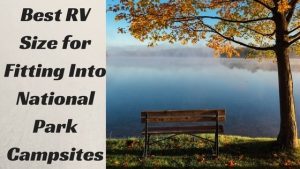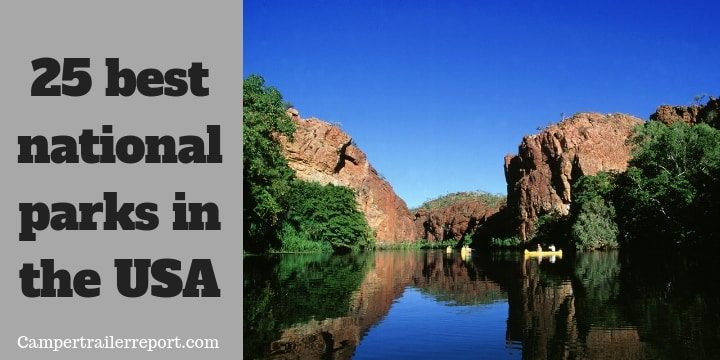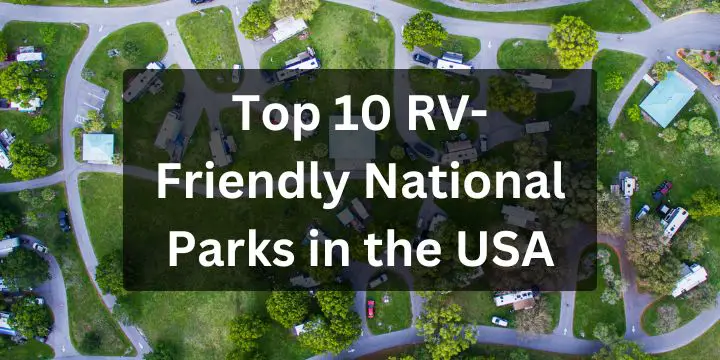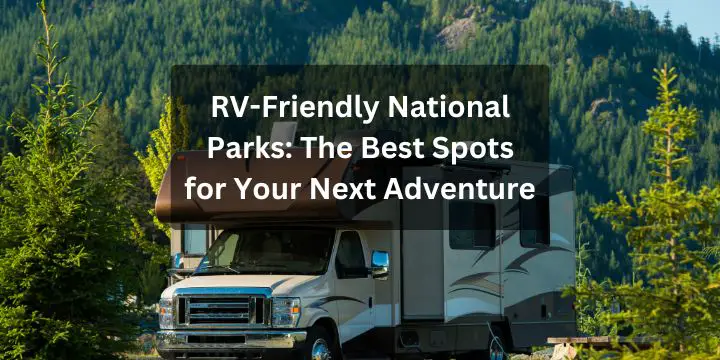In this article, you will learn what are the best RV size for fitting into National Parks in the US.
Where do you escape for a weekend between the busy work schedule? All cities offer almost the same leisure that probably is already available in your city. The best option then is to go to the national parks and enjoy a weekend with family surrounded by nature and free from polluted air.
As the national parks don’t have buildings and lodges to stay in, people must depend on staying in tents, trailers, or recreational vehicles. All the national parks have specific spots for camping and parking recreational vehicles (RVs) and trailers.
RVs are good to have and comfortable to stay in. They offer comfort, space, and security. But many people find that the RVs they purchase cannot be parked at many of the national park sites. One needs to consider this before buying an RV.
A case study shows that the optimal RV length for camping in national parks is 35′ or less. With this size, you can always find a spot to handle your rig in most parks. Hence it can be safely concluded that the ideal length for an RV should be 35 feet this can be taken as the broad guideline while purchasing an RV.
Best RV size for traveling.
Please study the road to the place you will be visiting often. There are steep winding mountain roads where some of the big-sized RVs may not be able to go. It is better to know the conditions including low-clearance areas.
Suddenly finding yourself at a place where you cannot proceed further and a compulsion to take a U-turn is unpleasant.
Most of the narrow mountain roads are not suitable to take U-turns with big-sized rigs. There are travel guides which can give you information about most of the routes to the national parks.
> You may also like:45 RV Accessory Must-Haves for Your Travel Trailer<<
A case study shows that the best RV size for traveling is between 25′ and 30′.
Different national parks have campsites that have parking spaces of different sizes. So, it is imperative to know the size of the parking lot and the size of your RV.
It is wise to measure the vehicle yourself and not depend on the specification given by the manufacturer. You should measure the length, width, and height of the RV including the slide-outs.
If you are using a fifth wheel, you need to measure the total along with the tow vehicle. A longer RV may give a lot more comfortable. But one doesn’t want to find out that they can’t park their vehicles on the spot they are visiting.
Please check the weight of the RV if you are buying a trailer or a fifth wheel.
You need to know whether the pick-up or car which you use for towing will be able to take the load. If you are buying a motorhome this issue won’t arise.
But if you plan to tow a car for driving around then you should know the towing capacity of the motorhome.
Height may not be a big issue in most places. But there are roads with low-clearance areas. It is better to know this beforehand so that you don’t find that you have to take a different route.
Though other dimensions are important to an extent, it is the length of the vehicle that is the crucial factor to consider when buying an RV.
What Are the Best RV Lengths for National Parks?
All of the following numbers from the list are COMBINED lengths of the tow vehicle and the trailer so you need to add the length of the RV and the vehicle together.
Here are the averages lengths: RVs up to 12′ fit in all national parks, from 19′ to 25′ in length fit in 91%, from 25′ to 32′in length fit in77%, from 32′ to 37′ in length fit in 58% and RVs up to 40′ in length fit in 50% of all national parks in the US.
To make things easier I decided to study the size restrictions of the most popular national parks in the country.
RV Size Limits for Most Popular National Parks
Most sites in the Yellowstone national park permitted a size of 40 feet for RVs.
- Fishing Bridge RV Park – Up to 40′ RVs
- Canyon Village Campground – 40′ COMBINED RV length
- Bridge Bay Campground – 40′ COMBINED RV length
- Madison Campground – 40′ COMBINED RV length
- Grant Village Campground – 40′ COMBINED
At the Joshua Tree national park certain campgrounds had a very small allowance of 25 feet. But most other sites could accommodate an RV of size not exceeding 35 feet.
- Black Rock Campground – Half of the sites take in up to 25′ in combined length, and half go up to 35′.
- Hidden Valley Campground – The COMBINED length of RV and towed vehicle or toad is only 25′
- White Tank Campground – The COMBINED length of RV and towed vehicle or toad is only 25′
In the Yosemite Valley 12 sites – six each in Lower Pines and North Pines can take RVs up to 40 feet long. But there are many more sites that can take the size of only up to 35 feet.
At the Redwoods National and State Parks, California the size at the various sites ranges from a maximum of 36 feet to a minimum of 24 feet.
- Jedediah Smith Campground – Trailers 31′
- Mill Creek – Trailers 27′
- Elk Prairie – Trailers 24′,
- Gold Bluffs – Trailers PROHIBITED, motorhomes 24′
At the Great Smoky Mountains, the size of the various sites ranges from 12′ to 35′ for trailers.
- Abrams Creek – 12′
- Balsam Mountain – 30′
- Cade’s Cove – Trailers up to 35′ and Motorhomes up to 40′
- Cataloochee – 31′
- Cosby – 25′
- Deep Creek – 26′
- Elkmont – Trailers 32′, motorhomes 35′
- Look Rock – No limit
- Smokemont – Trailers 35′, motorhomes 40′
At Arcadia National Park
- Blackwoods Campground – 35′ in COMBINED length of the tow vehicle (or towed vehicle) and the RV itself.
- Seawall Campground – 35′ in COMBINED length of the tow vehicle (or towed vehicle) and the RV itself.
At Arches National Park
- Devil’s Garden Campground – 25% of the spots accommodate an RV and towed vehicle combined length of 25′. 25% of the spots take an RV up to 30′, and 25% of the spots can fit an RV up to 40′.
- Archview Campground – Up to 50′ in length, but you have to pay more for these premium spots.
- Moab Valley Campground – Up to 44′ in length, but you have to pay more for these premium spots.
Conclusion:
I wish everyone happy camping and a great time with families.
Related Post: First Time Travel Trailer Owner Tips, Beginner’s Guide.
Related Questions:
The size of the RV is one of the most important factors when it comes to fitting into National Park campsites. Not all of these have campgrounds that will be suitable for your RV. It’s important to know what size park your RV will be able to fit into. Make sure that you’re familiar with the campground restrictions of each National Park beforehand, so you are not caught unawares when traveling through them. Here are most of the questions Rvers ask.
What size RV is allowed in Yellowstone?
Many travelers have been denied entry into this national park for driving non-compliant RVs. What does non-complaint RV mean? It’s an RV with a length longer than 21feet and 8inches or width more than 8feet and 6inches, hence not be allowed to enter.
What is the best length RV for state parks?
RVing offers a lot of freedom. It is the ultimate in nomad-like living! Not all parks and campgrounds have long enough electrical and sewer connections for larger RVs. If you are looking to buy an RV, a 30′ class C might be the perfect size to give you everything that you want without being too big to fit into smaller campgrounds or parks with limited space.
What is the average size of an RV campsite?
The average size of an RV campsite is 30 feet by 50 feet. The typical campsite measures about 28 feet wide, 50 feet deep, and 8 to 9 feet between the front side of one side and the backside of the next.
What is the best size RV to buy?
There are trailers as small as 20 feet long and 5 feet wide, and there are motorhomes that are as long as 45 feet. A good starting point is to decide how many people you can have slept in the RV at one time and if you have a pet or two.
Don’t be pressured into buying an RV that’s just a little bit too big. The fancier an RV is, the higher the price tag will be. It’s better to buy an RV that has fewer extra features and lower monthly payments.
Video Overview: What is the Ideal RV Length for RV Living?
Video Overview: Best RV Length for Fitting in National Park Campgrounds
What does Boondocking mean?
Boondocking is when the RV parks for free at a destination called boondocking spot. Boondocking itself isn’t illegal; legal requirements vary from state to state or province to province.
> You may also like:Worst 5th Wheel Brands to Avoid <<
Is a 40-foot motorhome too big?
Some people would consider a 40-foot motorhome to be the perfect size for long-term travel as it has all the amenities you need and it’s also small enough to move around. However, there are people who consider a 40’ to be too big and would prefer one that is smaller because they miss out on many opportunities for adventure and it is harder to get into campgrounds at most parks.
Video Overview: Is a 40+ Foot Motorhome Too Big For National Parks?
Can you drive an RV through Arches National Park?
Yes, according to the park service’s website “all vehicles including RVs are allowed on all roads unless specifically posted otherwise.” However, they would prefer if visitors didn’t.
Video Overview: Arches National Park Utah: Travel Tips for a Single Day [4K]
Can I park my RV overnight at Cracker Barrel?
Yes, you can park your RV overnight at Cracker Barrel. Cracker Barrel has always been a popular place for both families and RVers alike, due to their reasonable prices on food.
> You may also like: 25 Best National Parks in the USA <<



